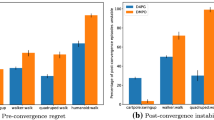Abstract
A mathematical model based on the competition between neural networks is proposed. The model proposes that the neural network controlling the lever-pressing response during variable-interval schedules of reinforcement should compete with all other behavior-controlling networks. The network with the highest activity would be expressed as a behavior by a winner-take-all mechanism. This theoretical model fits the interresponse time distributions in 95% of cases at p<0.05 significance level, and 100% of cases at p<0.01, when tested with the Kolmogorov-Smirnoff test of goodness of fit. The model is discussed in psychological terms and possible generalizations are suggested.
Similar content being viewed by others
References
BLOUGH, D. S. (1966). The reinforcement of least-frequent interresponse times. Journal of the Experimental Analysis of behavior, 9, 581–591.
BLOUGH, P. M., & BLOUGH, A. J. (1968). The distribution of interresponse times in the pigeon during variable interval reinforcement. Journal of the Experimental Analysis of behavior, 11, 23–27.
BULLOCK, T. H. (1970). The reliability of neurons. Journal of General Physiology, 55, 565–584.
FELDMAN, J. A., & BALLARD, D. H. (1982). Connectionist models and their properties. Cognitive Science, 6, 205–254.
GALBICKA, G., & BRANCH, M. N. (1981). Selective punishment of interresponse times. Journal of the Experimental Analysis of behavior, 35, 311–322.
GÓMEZ, C., CANALS, J., TORRES, B., & DELGADO-GARCIA, J. M. (1986). Analysis of the fluctuations in the interspike intervals of abducens nucleus neurons during ocular fixation in the alert cat. Brain Research, 381, 401–404.
GÓMEZ, C., QUERO, J. M., & ESCUDERO, M. (1989). Computer simulation of the neural discharge carried by the abducens nerve during eye fixation in the cat. International Journal Biomedical Computing, 24, 207–215.
GÓMEZ, C., RUIZ-ADAN, A., LLOSA, M., & RUIZ, G. (1992). Quantitative analysis of Irt variability during the first training stages of a variable interval schedule in rats. The Psychological Record, 42, 273–284.
GOTTMAN, J. M. (1981). Time series analysis. A comprehensive introduction for social scientists. London: Cambridge University Press.
JOHNSON, N. I., & KOTZ, S. (1970). Continuous univariate distributions-1. Boston: Houghton Mifflin Company.
KILLEEN, P. R., & FETTERMAN, J. G. (1988). A behavioral theory of timing. Psychological Review, 95, 274–295.
KINTSCH, W. (1965). Frequency distribution of interresponse times during VI and VR reinforcement. Journal of the Experimental Analysis of behavior, 8, 347–352.
MAZUR, J. E. (1990). Learning and behavior. Englewood Cliffs, NJ: Prentice Hall.
PAGE, S., & NEURINGER, A. (1985). Variability is an operant. Journal of Experimental Psychology: Animal Behavior Processes, 11, 429–452.
PEAR, J. J. (1985). Spatio-temporal patterns of behavior produced by variable-interval schedules of reinforcement. Journal of Experimental Analysis of behavior, 44, 217–231.
SOKAL, R. R., & ROHLF, F. S. (1981). Biometry. New York: W. H. Freeman.
YUILLE, A. L., & GRZYWACZ, N. M. (1989). A winner-take-all mechanism based on presynaptic inhibition feedback. Neural Computation, 1, 334–347.
Author information
Authors and Affiliations
Additional information
This work was supported by grants from the Junta de Andalucia, Sevilla University and the DGICYTTM90-152.
Rights and permissions
About this article
Cite this article
Gómez, C. A Competition Model of IRT Distributions During the First Training Stages of Variable-Interval Schedule. Psychol Rec 42, 285–293 (1992). https://doi.org/10.1007/BF03399602
Published:
Issue Date:
DOI: https://doi.org/10.1007/BF03399602




